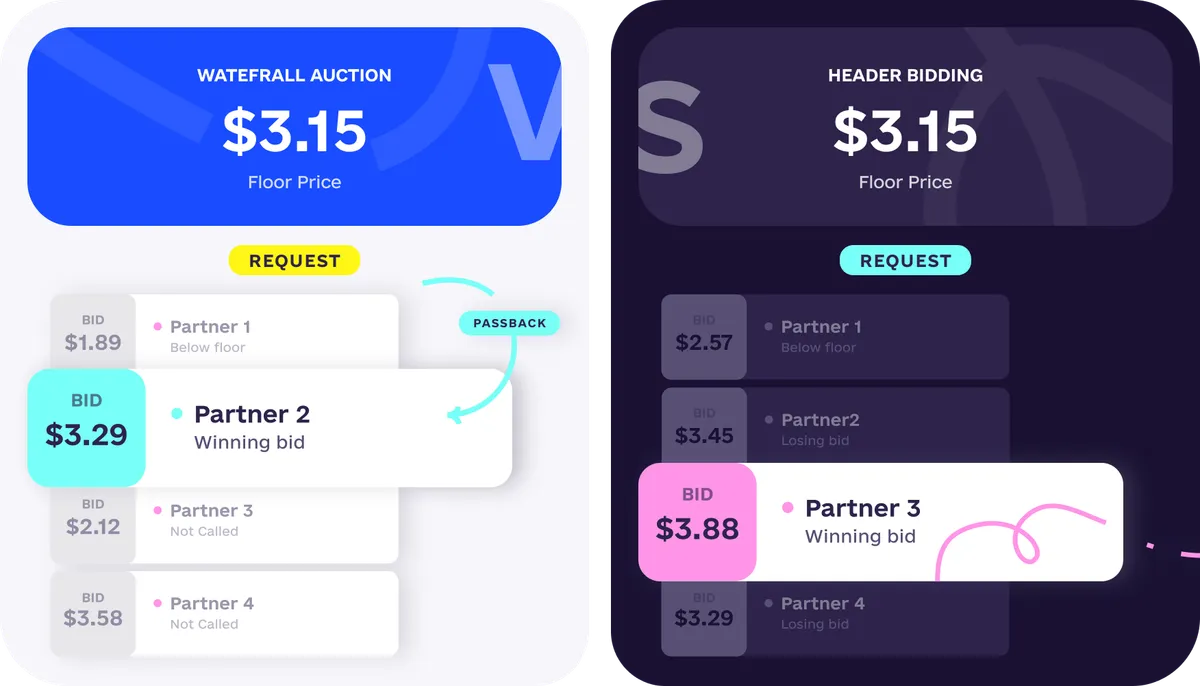Programmatic technology allows for automating the process of buying and selling ad space, which makes it preferable for both marketers and publishers. However, real-time bidding, which is most often associated with programmatic, is not the only option available. In this guide, we will review different types of programmatic advertising and explore their benefits and challenges.
4 Types of Programmatic Advertising
So, here are four programmatic advertising types that are important to be aware of.
RTB (Real-Time Bidding)
Being the most common form of programmatic, RTB implies purchasing and selling ad inventory via a real-time auction. When an impression opportunity arises, advertisers compete for the ad space, and the winning advertisement is then delivered to a publisher and displayed to users.
Benefits
For media buyers, RTB allows for more precise targeting, higher relevance of the ads, and an increase in ROI.
For publishers, RTB means access to a wider pool of marketers.
Challenges
The lack of transparency and control.
Publishers are unaware of marketers bidding for their inventory.
Ads can end up next to inappropriate content, causing potential risks to advertisers’ reputations.
PMP (Private Marketplace)
PMP also operates on an auction basis, but only selected marketers can participate. Such a marketplace can be invite-only, which implies access to the premium ad inventory. Alternatively, it can be available to all the advertisers who meet publishers’ requirements. This ensures a wider range of inventory, but its quality may vary.
Benefits
Access to high-quality publishers for advertisers.
Publishers get an opportunity to increase their income and deliver more relevant ads.
Publishers know who advertisers are, and vice versa. This ensures greater transparency and control, as well as improved brand safety.
Challenges
For media buyers, bidding on a PMP is usually more expensive.
For publishers, there is a risk of underestimating the demand for their exclusive ad space.
PMP is not immune to ad fraud.
Programmatic Guaranteed
Programmatic guaranteed removes the ad exchange from the process of buying and selling ad inventory. Advertisers purchase it directly from publishers. Thus, a marketer agrees to buy a certain number of impressions, while a publisher agrees to deliver the specified number of impressions for a fixed price.
Benefits
A high level of transparency for all the parties.
Advertisers can reach specific audiences on specific websites while having access to premium ad slots and eliminating pricing and delivery uncertainties.
Publishers get high-quality ads relevant to their audiences.
The risk of ad fraud is low since there are only two parties involved in the process.
Challenges
Getting into programmatic guaranteed often requires publishers to have a high-performing website.
A potentially limited selection of inventory.
Preferred Deals
This model implies a publisher providing a buyer with preferential access to their ad inventory during an auction (after negotiating pricing and other conditions). This means that a selected advertiser will be the first in the line when the auction starts.
Benefits
Advertisers benefit from flexibility and improved brand safety.
Publishers have improved price and quality control.
Preferred deals ensure greater transparency, as they are negotiated between only two parties.
Challenges
Advertisers are not obliged to bid on the ad space, so certain impressions may remain unfilled.
Marketers still take part in the auction since the deal is not guaranteed.
Emerging Trends In Programmatic Advertising
As the programmatic landscape keeps evolving, it is crucial to stay on top of trends. Here they are.
Header Bidding
Header bidding means offering ad inventory to multiple advertisers at once instead of offering it first to the top-tier buyers, then to the next tier, and so on. Publishers benefit from increased competition and the maximum value of inventory, while advertisers have equal opportunities.

SPO (Supply-Path Optimization)
SPO is about identifying the number of intermediaries between a demand-side platform and a publisher and optimizing this path to make it as short and profitable as possible. For instance, this can involve establishing direct connections with publishers, working only with a selected number of supply-side platforms, etc. Adopting SPO also allows advertisers to avoid duplicated auctions during header bidding.
The Rise Of AI
The operation of programmatic advertising heavily relies on AI, but there are many more applications entering the stage. For instance, AI can be used for content generation, improved targeting and personalization, more effective quality assurance, and even campaign planning. It is important to keep an eye on its rapid advancements that bring benefits both to marketers and publishers.
Consider Attekmi Your Trusted Partner
For ad exchange owners, it is crucial to meet the needs of advertisers and publishers to keep their platforms profitable. Using solutions like those offered by Attekmi can significantly simplify this task.
Here are the integration options that we support:
OpenRTB 2.6
VAST to RTB
VAST to All
VAST to VAST
JS tags
Header bidding
DSP and SSP connectors for specific integrations
Besides, it offers multiple programmatic targeting options, as well as different types of programmatic ads, including banner, video, audio, native, pop, and CTV ads.
With Attekmi, you do not have to build an ad exchange platform from scratch. Instead, you can start earning on media trading quickly. And since our solutions are regularly updated with new functionalities, you can rest assured that your ad exchange will remain competitive.
Does Attekmi seem to be the right solution? Then let’s get in touch!
FAQ
What are the four main types of programmatic advertising?
Among different types of programmatic advertising, there are four main options to consider: RTB (real-time bidding), PMP (private marketplace), programmatic guaranteed, and preferred deals. Each of them has its specific benefits and challenges, so it is essential for advertisers and publishers to understand their needs and possibilities before choosing a model.
Which type of programmatic advertising is the most effective?
Choosing a model depends on multiple factors, like the volume of traffic on the publisher’s website, the advertiser’s budget, etc. Both parties have to understand their requirements and continuously analyze their performance under the selected model to be able to adjust their strategies.
Which programmatic model is the most secure?
The fewer parties are involved in the process, the better. Programmatic guaranteed implies direct deals between media buyers and publishers, meaning that the risk of ad fraud and malicious activities decreases.
 By Iryna Kozirevych
By Iryna Kozirevych